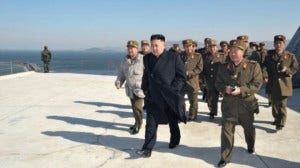U.S. To Increase Missile Defense [VIDEO]
The White House moves to resume deployment of a West Coast missile defense system that it halted four years ago, citing a growing threat from North Korea.
FOX News Radio’s Mike Majchrowitz has reports from the White House:
The Administration will deploy 14 interceptors at a site in Alaska. The President canceled the interceptors in his first term, but new developments brought a change of heart.
Hagel: “We will strengthen our homeland defense, maintain our commitments to our allies and partners, and make clear to the world the United States stands firm against aggression.”
Defense Secretary Chuck Hagel says a new radar installation will also be built in Japan. Alabama House Republican Mike Rogers welcomed the decision, but he says the delay will cost money.
Rogers: “The interceptors are going to cost a lot more than they would have four years ago, so it’s going to be a big hit to our budget.”
The Pentagon estimating this will cost a billion dollars and take four years.
At the White House, Mike Majchrowitz, FOX News Radio.
WATCH more on the increase in U.S. missile defense:
Below read a reaction statement from Senator Inhofe (R-OK)
“By restoring the 14 Ground based interceptors to Fort Greely, Alaska, we add a much needed measure of protection against the North Korean threat,” said Inhofe. “Sec. Hagel’s announcement is a step in the right direction but does not go far enough to address the threat from Iran which, according to the Department of Defense, could test an Intercontinental ballistic missile as early as 2015. Reflecting concerns by Congress, the fiscal year 2013 National Defense Authorization Act directs the President to develop a contingency plan for the deployment of a homeland missile defense interceptor site on the East Coast of the United States. In light of this recent announcement, and the increase in Iran’s nuclear activities, I call on the President to turn that contingency plan into a deployment order.”
Read Defense Secretary Hagel’s remarks on Missile Defense as prepared for delivery:
Good afternoon.
I have a statement and then I will take a couple questions then ask the Under Secretary and the Vice Chief to address the specific questions you have about the topic that we are going to about: Missile Defense.
Today, I am announcing a series of steps the United States will take to stay ahead of the challenge posed by Iran and North Korea’s development of longer-range ballistic missile capabilities.
The United States has missile defense systems in place to protect us from limited ICBM attacks, but North Korea in particular has recently made advances in its capabilities and has engaged in a series of irresponsible and reckless provocations.
Specifically, North Korea announced last month that it conducted its third nuclear test, and last April displayed what appears to be a road-mobile ICBM. It also used its Taepo Dong-2 missile to put a satellite in orbit, thus demonstrating progress in its development of long-range missile technology.
In order to bolster our protection of the homeland and stay ahead of this threat we are taking four steps.
First, we will strengthen homeland missile defense by deploying 14 additional Ground-Based Interceptors (GBIs) at Ft. Greely, Alaska. That will increase the number of deployed Ground Based Interceptors from 30 to 44, including the four GBIs at Vandenberg Air Force Base in California. These additional GBIs will provide a nearly 50 percent increase in our missile defense capability.
Second, with the support of the Japanese government, we are planning to deploy an additional radar in Japan. This second TPY-2 ortippy-tworadar will provide improved early warning and tracking of any missile launched from North Korea at the United States or Japan.
Third, as directed by Congress, we are conducting Environmental Impact Studies for a potential additional GBI site in the United States. While the Administration has not made any decision on whether to proceed with an additional site, conducting Environmental Impact Studies will shorten the timeline for construction should that decision be made.
And fourth, we are restructuring the SM-3 IIB program. As many of you know, we had planned to deploy the SM-3 IIB as part of the European Phased Adaptive Approach. The purpose was to add to the protection of the U.S. homeland already provided by our current GBIs against missile threats from the Middle East. The timeline for deploying this program had been delayed to at least 2022 due to cuts in congressional funding. Meanwhile, the threat matures. By shifting resources from this lagging program to fund the additional GBIs as well as advanced kill vehicle technology that will improve the performance of the GBI and other versions of the SM-3 interceptor, we will be able to add protection against missiles from Iran sooner while also providing additional protection against the North Korean threat.
Let me emphasize the strong and continued commitment of the United States to NATO missile defense. That commitment remains ironclad. The missile deployments the United States is making in phases one through three of the European Phased Adaptive Approach, including sites in Poland and Romania, will still be able to provide coverage of all European NATO territory as planned by 2018.
The collective result of these four decisions will be to further improve our ability to counter future missile threats from Iran and North Korea, while maximizing increasingly scarce taxpayer resources. The American people expect us to take every necessary step to protect their security at home and U.S. strategic interests abroad, but they expect us to do so in the most efficient and effective manner possible. By taking the steps I’ve outlined today, we will strengthen our homeland defense, maintain our commitments to our allies and partners, and make clear to the world that the United States stands firm against aggression.
Thank you.








